








Soient \( (a, b) \in \hspace{0.05em}\mathbb{N}^2, \enspace a > b \).
L'algorithme d'Euclide nous dit que :
$$ \exists q \in \mathbb{N}, $$
$$ b / a \ \Longrightarrow \ a = bq \ \Longrightarrow \ PGCD(a, b) = b $$
$$ \exists q \in \mathbb{N}, \enspace \exists R \in [\![0, (b-1) ]\!] , $$
$$ b \nmid a \ \Longrightarrow \ a = bq + R $$
Le \( PGCD(a, b) \) est le dernier reste non nul \( R_n \) de la division euclidienne de \( a \) par \( b \) tel que :
$$ a = \textcolor{#A65757}{b} q_0 + \textcolor{#446e4f}{R_0} $$
Tant que le reste ne divise pas le diviseur de la division précédente, on continue l'algorithme.
On redécompose alors à chaque étape le nouvel élément :
$$ b = \textcolor{#A65757}{R_0} q_1 + \textcolor{#446e4f}{R_1} \ \Longrightarrow \ R_0 = \textcolor{#A65757}{R_1} q_2 + \textcolor{#446e4f}{R_2} \ \Longrightarrow \ R_k = \textcolor{#A65757}{R_{k + 1}} q_{k + 2} + \textcolor{#446e4f}{R_{k + 2}} $$
$$ jusque \ \Longrightarrow R_{n - 3} = q_{n -1 }\textcolor{#A65757}{R_{n - 2}} + \textcolor{#446e4f}{R_{n -1}} $$
Tant que le reste \( R_{n - 1} \) ne divise toujours pas \( R_{n - 2} \), le reste \( R_{n - 2} \) peut s'écrire :
$$ R_{n - 2} = q_{n}\textcolor{#A65757}{R_{n - 1}} + \textcolor{#446e4f}{R_{n}} $$
Jusqu'au moment où enfin \( R_n \) divise \( R_{n - 1} \), alors \( R_{n - 1} \) s'écrira :
$$ R_{n - 1} = q_{n + 1}\textcolor{#A65757}{R_{n}} $$
À ce moment, par remontée de l'algorithme en injectant tour à tour les valeurs précédentes jusque \( a \) et \( b \), on se rendra compte que l'on pourra toujours factoriser par \(R_{n} \). Et alors :
$$ PGCD(a, b) = R_{n} $$
\( \forall n \in \mathbb{N}\), \(\forall k \in [\![0, n ]\!] \), tant que le reste \(R_{k} \) ne divise pas le reste \(R_{k -1 } \) :
$$ a \nmid b \Longrightarrow PGCD(a, b) = PGCD(b, R_0) = PGCD(R_0, R_1) = \enspace ... \enspace = PGCD(R_{n - 1}, R_n) = R_n \neq 0$$
Soient deux entiers naturels \( (a, b) \in \hspace{0.05em} \mathbb{N}^2 \), avec \( a > b \).
Alors, \( a \) s'écrit :
$$ \exists q \in \mathbb{N}, \ a = bq \qquad (a) $$
Et à ce moment-là, comme \( b /a \) et \( b/b \), alors \( PGCD(a, b) = b\).
$$ \exists q \in \mathbb{N}, $$
$$ b / a \ \Longrightarrow \ a = bq \ \Longrightarrow \ PGCD(a, b) = b $$
Dans ce cas, \( a \) peut s'écrire sous la forme :
$$ \exists q_0 \in \mathbb{N}, \enspace \exists R_0 \in [\![0, (b-1) ]\!] , \enspace a = \textcolor{#A65757}{b}q_0 + \textcolor{#446e4f}{R_0} \qquad (a^*) $$
Alors, manière générale,
$$ \exists q \in \mathbb{N}, \enspace \exists R \in [\![0, (b-1) ]\!] , $$
$$ b \nmid a \ \Longrightarrow \ a = bq + R $$
Alors \( b \) s'écrit :
$$ \exists q_1 \in \mathbb{N}, \enspace b = q_1R_0 \qquad (b) $$
On peut remonter l'algorithme et injecter \( (b) \) dans \( (a^*) \) :
$$ a = bq_0 + R_0 = q_1R_0q_0 + R_0 = R_0 \underbrace{(q_1 q_0 + 1)} _\text{ \( Q_{a} \in \mathbb{N} \)} $$
Soit,
$$ a = Q_{a}R_0 \qquad (a') $$
On a alors,
$$ \Biggl \{ \begin{align*} a = Q_{a}R_0 \qquad (a') \\ b = q_1R_0 \qquad (b) \end{align*} $$
Et à ce moment-là, comme \( R_0 /a \), \( R_0/b \) et \( R_0/R_0 \), alors :
$$ PGCD(a, b) =PGCD(b, R_0) = R_0 $$
Dans ce cas, \( b \) peut s'écrire sous la forme :
$$ \exists q_1 \in \mathbb{N}, \enspace \exists R_1 \in [\![0, (R_0-1) ]\!], \enspace b = \textcolor{#A65757}{R_0} q_1 + \textcolor{#446e4f}{R_1} \qquad (b^*) $$
Alors \( R_0 \) s'écrit :
$$ \exists q_2 \in \mathbb{N}, \enspace R_0 = q_2R_1 \qquad (R_0) $$
On peut remonter l'algorithme et injecter \( (R_0) \) dans \( (b^*) \) :
$$ b = R_0 q_1 + R_1 = q_2R_1 q_1 + R_1 = R_1 \underbrace{(q_2 q_1 + 1)} _\text{ \( Q_{b} \in \mathbb{N} \)} $$
Soit,
$$ b = Q_{b}R_1 \qquad (b') $$
On remonte encore une fois en injectant cette fois la nouvelle valeur de \( (b') \) et de \( (R_0) \) dans \( (a^*) \) :
$$a = bq_0 + R_0 = Q_{b}R_1q_0 + q_2R_1 = R_1 \underbrace{(Q_{b} q_0 + q_2)} _\text{ \( Q_{a} \in \mathbb{N} \)} $$
$$a = Q_{a}R_1 \qquad (a') $$
On a alors,
$$ \Biggl \{ \begin{align*} a = Q_{a}R_1 \qquad (a') \\ b = Q_{b}R_1 \qquad (b') \end{align*} $$
Et à ce moment-là, comme \( R_1 /a \), \( R_1/b \), \( R_1/R_0 \) et \( R_1/R_1 \), alors :
$$ PGCD(a, b) =PGCD(b, R_0) =PGCD(R_0, R_1) = R_1 $$
Dans ce cas, \( R_0 \) peut s'écrire sous la forme :
$$ \exists q_2 \in \mathbb{N}, \enspace \exists R_2\in [\![0, (R_1-1) ]\!], \enspace R_0 = \textcolor{#A65757}{R_1} q_2 + \textcolor{#446e4f}{R_2} \qquad (R_0^*) $$
On continue l'algorithme comme cela jusqu'à ce que \( R_n \) divise \( R_{n- 1} \) et à ce moment-là :
$$ R_{n - 1} = q_{n + 1}\textcolor{#A65757}{R_n} $$
Ainsi, par remontée on aura :
$$ R_{n - 2} = q_{n} \textcolor{#A65757}{R_{n - 1}} + \textcolor{#446e4f}{R_n} $$
$$ R_{n - 2} = q_{n}\textcolor{#A65757}{q_{n + 1}R_n} + \textcolor{#446e4f}{R_n} = R_n\underbrace{(q_{n}q_{n + 1} + 1)} _ \text{ \( Q_{n - 2} \in \mathbb{N} \) } $$
$$ R_{n - 2} = R_nQ_{n - 2} $$
Par suite, on a une réaction en chaîne jusqu'au début de l'algorithme :
$$ \Biggl[ R_{n - 3} = R_nQ_{n - 3} \Biggr] \Longrightarrow ... \Longrightarrow \Biggl[ R_{n - k} = R_nQ_{n - k} \Biggr] \Longrightarrow ... \Longrightarrow \Biggl[ R_{2} = R_nQ_{2} \Biggr] $$
$$ \Biggl[ R_{1} = R_nQ_{1}\Biggr] \Longrightarrow \Biggl[ R_{0} = R_nQ_{0} \Biggr] \Longrightarrow \Biggl[ b = R_nQ_{b}\Biggr] \Longrightarrow \Biggl[ a = R_nQ_{a}\Biggr] $$
\( R_n \) sera alors le plus diviseur commun à tous ces nombres.
$$ PGCD(a, b) = PGCD(b, R_0) = PGCD(R_0, R_1) = \enspace ... \enspace = PGCD(R_{n - 1}, R_n) = R_n \neq 0$$
Et finalement,
\( \forall n \in \mathbb{N}\), \(\forall k \in [\![0, n ]\!] \), tant que le reste \(R_{k} \) ne divise pas le reste \(R_{k -1 } \) :
$$ a \nmid b \Longrightarrow PGCD(a, b) = PGCD(b, R_0) = PGCD(R_0, R_1) = \enspace ... \enspace = PGCD(R_{n - 1}, R_n) = R_n \neq 0$$
Ce reste \( R_n \) pourra lui-même se décomposer en différents facteurs, qui composeront l'ensemble des diviseurs de \( a \) et de \( b \) :
$$ \mathcal{D}(R_n) = \mathcal{D}\bigl(PGCD(a, b)\bigr) = \mathcal{D}(a,b) $$
On a vu avec l'algorithme qu'il va falloir effectuer des divisions successives, afin de récupérer le dernier reste non nul de cette série de division.
Calcul de \( 1365 / 25 \)
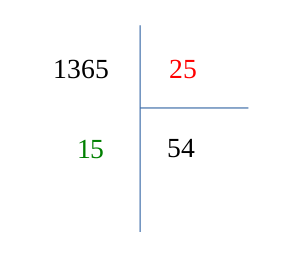
\( 25 \) ne divise pas \( 1365 \), car cela ne tombe pas juste. On récupère d'abord sa partie entière.
$$ \left \lfloor{\frac{1365}{25}} \right \rfloor = 54 \hspace{5em} (1^{ \textit{è} re} \ division) $$
Alors \( 1365 \) peut s'écrire :
$$ 1365 = \textcolor{#A65757}{25} \times 54 + \textcolor{#446e4f}{R_0} $$
Calculons le reste \( \textcolor{#446e4f}{R_0} \).
$$ \textcolor{#446e4f}{R_0} = 1365 -\textcolor{#A65757}{25} \times 54 = \textcolor{#446e4f}{15} \hspace{5em} (R_0) $$
Soit,
$$ 1365 = \textcolor{#A65757}{25} \times 54 + \textcolor{#446e4f}{15} \qquad (a) $$
$$ (a = \textcolor{#A65757}{b} q_0 + \textcolor{#446e4f}{R_0}) $$
Calcul de \( 25 / 15 \)
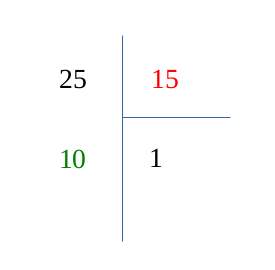
\( 15 \) ne divise pas \( 25 \).
$$ \left \lfloor{\frac{25}{15}} \right \rfloor = 1 \hspace{5em} (2^{ \textit{è} me } \ division) $$
Alors \( 25 \) peut s'écrire :
$$ 25 = \textcolor{#A65757}{15} \times 1 + \textcolor{#446e4f}{10} \qquad (b) $$
$$ (b = \textcolor{#A65757}{R_0} q_1 + \textcolor{#446e4f}{R_1}) $$
Calcul de \( 15 / 10 \)

\( 10 \) ne divise pas \( 15 \).
$$ \left \lfloor{\frac{15}{10}} \right \rfloor = 1 \hspace{5em} (3^{ \textit{è} me } \ division) $$
Alors \( 15 \) peut s'écrire :
$$ 15 = \textcolor{#A65757}{10} \times 1 + \textcolor{#446e4f}{5} \qquad (R_0) $$
$$ (R_0 = \textcolor{#A65757}{R_1} q_2 + \textcolor{#446e4f}{R_2}) $$
Calcul de \( 10 / 5 \)
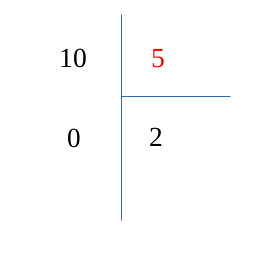
Cette fois-ci, \( 5 \) divise \( 10 \). Le reste est nul.
$$ \frac{10}{5} = 2 \hspace{5em} (4^{ \textit{è} me } \ division) $$
Alors \( 10 \) peut s'écrire :
$$ 10 = \textcolor{#A65757}{5} \times 2 \qquad (R_1) $$
$$ (R_1 = \textcolor{#A65757}{R_2} q_3) $$
On a donc comme résultat final :
$$ PGCD(1365, 25) = 5 $$
$$ (PGCD(a, b) = R_2) $$
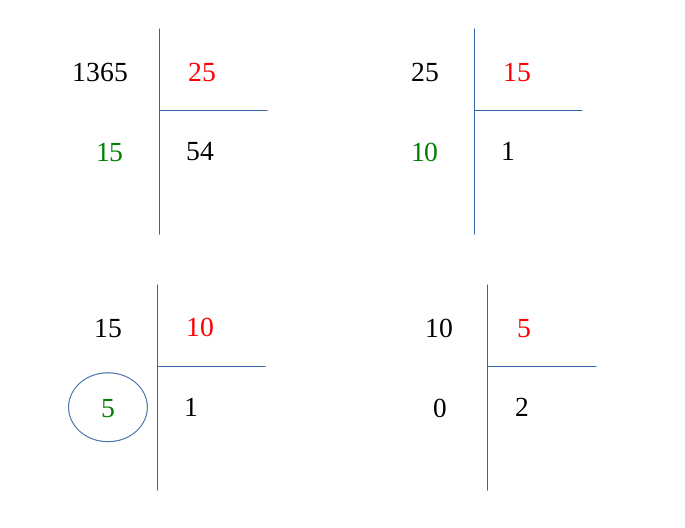
On peut éventuellement remonter l'algorithme et trouver deux nombres qui conviennent à l'indetité de Bézout.
Ce théorème nous dit que :
$$ \forall (a, b) \in \hspace{0.05em}\mathbb{N}^2, \enspace a > b, $$
$$ \delta = a \wedge b \hspace{0.2em} \Longrightarrow \hspace{0.2em} \exists (u, v) \in \hspace{0.05em}\mathbb{Z}^2, \enspace au + bv = \delta \qquad (Bachet-Bézout)$$
Pour cela, on va à chaque fois réinjecter les valeurs dans les résultats du calcul précédent.
$$ \Biggl \{ \begin{gather*} \underline{10} \hspace{0.1em} = \textcolor{#A65757}{5} \times 2 \qquad (R_1) \\ 15 = \hspace{0.1em} \underline{\textcolor{#A65757}{10}} \hspace{0.1em} \times 1 + \textcolor{#446e4f}{5} \qquad (R_0) \end{gather*} \enspace \Longrightarrow \enspace 15 = \textcolor{#A65757}{(5 \times 2)} \times 1 + \textcolor{#446e4f}{5} \qquad (R_0') $$
On isole la valeur du \( PGCD \) car c'est elle qu'on veut à la fin comme résultat.
$$ 15 = \textcolor{#A65757}{10} \times 1 + \textcolor{#446e4f}{5} \qquad (R_0) \enspace \Longleftrightarrow \enspace \textcolor{#446e4f}{5} = 15 - \textcolor{#A65757}{10} \times 1 \qquad (R_2) $$
Ensuite, on a :
$$ 25 = \textcolor{#A65757}{15} \times 1 + \textcolor{#446e4f}{10} \qquad (b) \enspace \Longleftrightarrow \enspace \textcolor{#446e4f}{10} = 25 - \textcolor{#A65757}{15} \times 1 \qquad (R_1') $$
Avec l'injection de \( (R_1') \) dans \( (R_2) \), on a :
$$ \Biggl \{ \begin{gather*} \textcolor{#446e4f}{5} = 15 - \hspace{0.1em} \underline{ \textcolor{#A65757}{10} } \hspace{0.1em} \times 1 \qquad (R_2) \\ \hspace{0.1em} \underline{ \textcolor{#446e4f}{10} } \hspace{0.1em} = 25 - \textcolor{#A65757}{15} \times 1 \qquad (R_1') \end{gather*} \enspace \Longrightarrow \enspace \textcolor{#446e4f}{5} = 15 - ( 25 - \textcolor{#A65757}{15} \times 1 ) \times 1 \qquad (R_2') $$
Encore, on a :
$$ 1365 = \textcolor{#A65757}{25} \times 54 + \textcolor{#446e4f}{15} \qquad (a) \enspace \Longleftrightarrow \enspace \textcolor{#446e4f}{15} = 1365 - \textcolor{#A65757}{25} \times 54 \qquad (R_0'') $$
Avec la double injection de \( (R_0'') \) dans \( (R_2') \), on a :
$$ \Biggl \{ \begin{gather*} \hspace{0.1em} \underline{ \textcolor{#446e4f}{15} } \hspace{0.1em} = 1365 - \textcolor{#A65757}{25} \times 54 \qquad (R_0'') \\ \textcolor{#446e4f}{5} = \hspace{0.1em} \underline{ 15 } \hspace{0.1em} - ( 25 - \hspace{0.1em} \underline{ \textcolor{#A65757}{15} } \hspace{0.1em} \times 1 ) \times 1 \qquad (R_2') \end{gather*} \enspace \Longrightarrow \enspace \textcolor{#446e4f}{5} = 1365 - \textcolor{#A65757}{25} \times 54 - ( 25 - ( 1365 - \textcolor{#A65757}{25} \times 54 ) \times 1 ) \times 1 \qquad (R_2'') $$
Soit,
$$ \textcolor{#446e4f}{5} = 1365 - \textcolor{#A65757}{25} \times 54 - 25 + 1365 - \textcolor{#A65757}{25} \times 54 \qquad (R_2''') $$
$$ \textcolor{#446e4f}{5} = 1365 \times 2 + \textcolor{#A65757}{25} \times (-54 - 54 -1) $$
$$ \textcolor{#446e4f}{5} = 1365 \times 2 + \textcolor{#A65757}{25} \times (-109) $$
On a bien :
$$ 5 = 1365 \wedge 25 \hspace{0.2em} \Longrightarrow \hspace{0.2em} \exists (u, v) \in \hspace{0.05em}\mathbb{Z}^2, \enspace 1365u + 25v = 5 $$
$$ avec \ \Biggl \{ \begin{gather*} u = 2 \\ v = -109 \end{gather*} $$
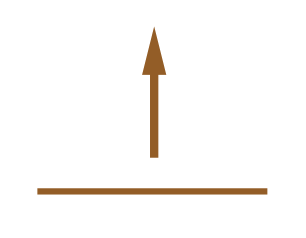 Retour en haut de page
Retour en haut de page